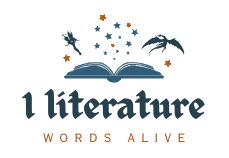In Stephen King's "The Stand," you experience an epic tale of survival following a devastating pandemic that wipes out most of humanity. You'll watch characters like Mother Abigail, symbolizing hope, and Randall Flagg, representing chaos, clash in a battle between good and evil. The novel's rich themes explore moral dilemmas and human resilience against societal collapse. King's vivid writing pulls you into the emotional stakes, making you feel every pang of loss. As you journey through this dark landscape, you'll uncover insights that resonate with today's challenges and reveal more about what makes this work a cornerstone of modern literature.
Overview of The Stand
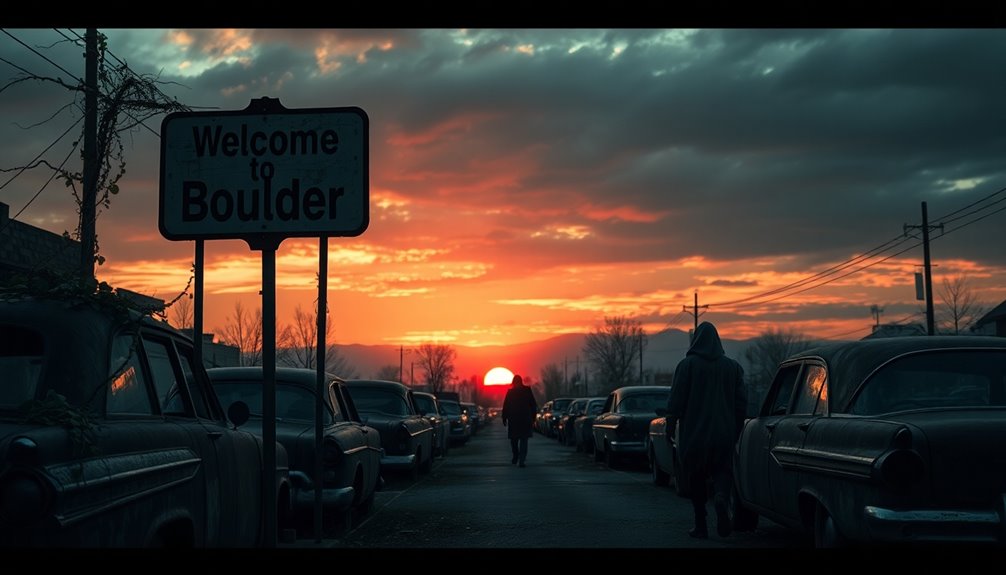
Stephen King's "The Stand" is a monumental exploration of humanity's struggle for survival in the face of a devastating pandemic. This epic post-apocalyptic novel, first published in 1978 and expanded in 1990, spans approximately 1,153 pages, immersing you in a world ravaged by a deadly super flu known as Captain Trips.
The outbreak decimates over 99% of the global population, setting the stage for an intense battle between good and evil. The consequences of such a pandemic reflect the potential rise in addiction and overdose cases that may strain healthcare systems, highlighting the fragility of societal structures during crises. This scenario echoes the generational poverty faced by families in urban settings, illustrating how crises can exacerbate existing vulnerabilities.
The narrative is structured into two main parts: the initial survival experiences of the characters and the climactic confrontation between the forces of good, led by Mother Abigail, and the dark, manipulative Randall Flagg.
You'll encounter a diverse cast, each grappling with personal struggles and moral dilemmas as they navigate this chaotic new world.
Themes of societal collapse and moral choices resonate throughout the story, reflecting deep-seated fears that are particularly relevant in times of crisis. The importance of mental health during such crises underscores the characters' journeys as they cope with loss and uncertainty.
As you plunge into The Stand, you'll find yourself questioning what it means to be human when faced with the ultimate challenge of survival and the eternal conflict of good versus evil.
Plot Summary and Analysis
In "The Stand," you witness the catastrophic release of Captain Trips, a virus that wipes out most of humanity and sets the stage for a gripping struggle between good and evil.
As survivors gather around Mother Abigail or Randall Flagg, you're drawn into their moral dilemmas and personal transformations. The theme of resilience and hope serves as a guiding beacon for characters as they confront adversity and strive to rebuild their lives in a fractured world. The narrative mirrors the journey of the Joad family in "The Grapes of Wrath," who also exemplify the human spirit's resilience in the face of overwhelming hardship.
This conflict shapes the journey of rebuilding society, highlighting both the resilience of the human spirit and the darker impulses that can arise in chaos. The narrative echoes the themes of resilience amidst adversity found in stories like "The Book Thief," where characters face overwhelming challenges yet find ways to endure and resist.
Pandemic Outbreak Initiation
The accidental release of Captain Trips sets free chaos, as a highly contagious super flu quickly spirals out of control, leading to a global pandemic within mere days. This lethal virus, born from a military lab, triggers an alarming global outbreak that overwhelms healthcare systems.
The frantic response from society is palpable as infected individuals flee, transmitting the super flu across cities and states, with the U.S. government's attempts at a cover-up only exacerbating the situation.
As the death toll rises, you witness the rapid collapse of society, with over 99% of the population succumbing to the virus. Amidst the chaos, a small group of survivors emerges, each guided by prophetic dreams. They find themselves torn between the benevolent Mother Abigail and the malevolent Randall Flagg, setting the stage for an epic struggle.
King's portrayal of this pandemic resonates deeply with contemporary fears, reminding us just how vulnerable civilization is to biological threats. You can't help but feel the weight of societal fragility as the characters navigate a world transformed by the relentless grip of Captain Trips.
Good vs. Evil Conflict**
How do the forces of good and evil shape the lives of the survivors in "The Stand"? In this gripping narrative, characters are drawn into a battle between Mother Abigail, who embodies hope and morality, and Randall Flagg, the embodiment of chaos and malevolence.
As the survivors navigate the aftermath of the devastating Captain Trips pandemic, they're faced with critical moral choices that define their paths.
Mother Abigail's prophetic dreams offer a guiding light, encouraging unity and righteousness among the survivors. Her community-centered approach fosters resilience, reminding you of the strength found in togetherness.
In stark contrast, Flagg exploits fear and the desire for power, manipulating individuals for his sinister ends. This tension between good and evil isn't merely symbolic; it manifests in the characters' struggles and decisions as they seek their place in a shattered world.
Ultimately, the climactic confrontation encapsulates the eternal struggle between these opposing ideologies. The fate of humanity hangs in the balance, underscoring the importance of community, hope, and the moral choices that shape the survivors' destinies.
In "The Stand," good and evil are more than abstract concepts; they dictate the course of survival and the potential for rebuilding society.
Character Exploration
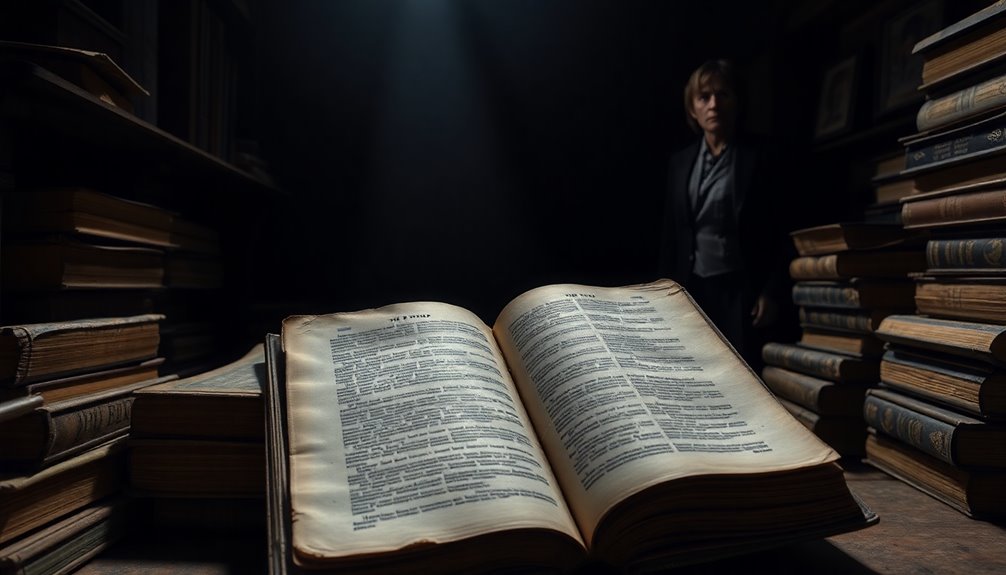
Exploring the characters in "The Stand" reveals a rich tapestry of human experience in the face of overwhelming adversity. Each character faces their own struggles, making them relatable and compelling.
- Larry Underwood transforms from a self-serving musician into a courageous leader, showcasing remarkable personal growth. His journey reflects the importance of cultivating inner strength to navigate life's complexities.
- Harold Lauder embodies resentment and jealousy, representing a relatable form of human evil, contrasting sharply with the supernatural menace of Randall Flagg.
- Frannie Goldsmith navigates her pregnancy while grappling with relationships, initially portrayed as strong but ultimately experiencing a negative shift by the story's end.
- Nick Andros, a deaf-mute, symbolizes resilience and adaptability, forging deep connections with survivors like Tom Cullen, emphasizing the importance of support and camaraderie.
In addition, Trashcan Man adds depth to the narrative with his tragic backstory and chaotic behavior, illustrating how trauma shapes individuals in this apocalyptic world.
Each character contributes to the overarching narrative, reflecting the multifaceted nature of humanity when confronted with despair and hope. Their journeys intertwine, creating a powerful exploration of what it means to survive and connect in trying times. This mirrors the importance of empowerment in overcoming personal struggles, as highlighted in tales of survival and hope.
Major Themes
In "The Stand," you'll see the intense battle between good and evil, with Mother Abigail and Randall Flagg as their powerful symbols.
The story also forces you to confront the moral dilemmas that arise when society collapses, pushing characters to make choices that shape their futures. This echoes the power dynamics explored in Richard Wright's "Native Son," where societal structures influence individual actions. Additionally, the narrative reflects the ethical implications of choices made in crisis situations, similar to Henrietta Lacks' story as it reveals the complexities of consent and ownership.
This exploration of human nature amidst chaos highlights the fragility of civilization and the resilience required to rebuild. The narrative echoes the spirit of collective action as characters unite to face the darkness threatening their future.
Good vs. Evil
Struggling with the forces of good and evil is at the heart of "The Stand," where Mother Abigail symbolizes hope and morality, while Randall Flagg embodies chaos and malevolence. This epic conflict shapes the characters as they confront their own moral dilemmas amid society's collapse. The choices they make, often guided by prophetic dreams, reveal their true natures and the internal battles they face.
Key elements of this theme include:
- The stark contrast between altruism and malevolence.
- Characters drawn to either Mother Abigail or Randall Flagg, showcasing their moral standings.
- The duality of human nature, where darker impulses clash with the desire for redemption.
- The impact of fear and desperation on decision-making during critical moments.
Through these dynamics, King illustrates that the struggle between good and evil isn't just an external battle; it's an intrinsic part of the human experience.
As you read, you'll see how each character's journey reflects the broader conflict, forcing you to ponder what it truly means to choose between good and evil in a fractured society.
Human Morality Exploration
Human morality takes center stage in "The Stand," as characters face profound choices that reveal their true selves. Mother Abigail, a symbol of good, and Randall Flagg, the embodiment of evil, stand in stark contrast, pushing others to confront moral dilemmas.
You'll see key figures like Larry Underwood and Harold Lauder wrestling with their inner demons, steering through an unpredictable post-apocalyptic landscape where ethical choices hold significant weight.
The narrative intricately explores free will versus predestination, as survivors are drawn to their respective leaders through prophetic dreams, challenging their moral compasses. In a world teetering on the brink of societal collapse, cooperation becomes essential; characters endeavor to rebuild community bonds, underscoring how vital interpersonal relationships are in times of adversity.
As the story unfolds, the deaths of both heroes and villains highlight the unpredictable nature of fate, illustrating how actions have consequences in this fractured reality.
Ultimately, "The Stand" invites you to reflect on the essence of humanity, urging you to contemplate what ethical choices you might make when faced with dire circumstances. The journey through morality in this epic tale resonates long after you turn the last page.
Societal Collapse Implications
Societal collapse reveals the fragility of human civilization and the complexities of moral choice in "The Stand." As Captain Trips devastates the population, the remnants of society must grapple with the implications of their decisions in a lawless world.
This narrative showcases the duality of human morality, highlighting how good guys and bad guys emerge amidst chaos.
In this new society, characters confront moral dilemmas that challenge their ethical beliefs:
- The struggle between cooperation and selfishness in survival.
- The choice between following a charismatic leader or fostering democracy.
- The impact of fear on decision-making and community cohesion.
- The potential for redemption or corruption in the face of despair.
As they navigate these challenges, the formation of two contrasting communities becomes evident: the hopeful Boulder Free Zone and the tyrannical Las Vegas ruled by Randall Flagg.
Each decision echoes the larger question of what defines humanity when civilization crumbles. Ultimately, "The Stand" serves as a poignant reminder of our vulnerability and the choices that shape our new society after a catastrophic event.
Writing Style and Techniques

Stephen King's writing style in "The Stand" captivates readers through a blend of rich descriptions and sharp vignettes, creating a narrative rhythm that pulls you in. His extensive descriptive passages immerse you in the post-apocalyptic landscape, with vivid imagery like the haunting portrayal of the New York Lincoln tunnel, which evokes a strong sense of place. This setting becomes a character in itself, amplifying the emotional stakes throughout the story. Additionally, the contrast between courageous protagonists and their dark surroundings adds depth to the narrative. Yates' exploration of disillusionment in society resonates with King's themes, emphasizing the struggles faced by individuals in both narratives.
King masterfully varies the narrative pace, heightening suspense during critical moments, particularly in scenes of societal collapse and character confrontation. The dialogue feels authentic, reflecting natural speech patterns that enhance character development and believability. However, some arcs may come off as predictable, which can detract from the overall experience.
Additionally, King skillfully weaves in supernatural elements and prophetic dreams, using them to explore profound moral questions about good and evil. This interplay of character journeys with existential themes invites you to reflect on the deeper implications of humanity's choices. The psychological tension in his storytelling enhances the reader's engagement, making every twist of the narrative even more impactful.
In "The Stand," King's writing style not only entertains but also challenges you to ponder the complexities of life and morality in a broken world.
Cultural Impact and Reception
Exploring the cultural impact and reception of "The Stand" reveals its lasting significance in horror literature and beyond. Since its publication in 1978, it's influenced how we perceive pandemics, especially during health crises like the swine flu outbreak.
The novel's uncut edition, released in 1990, expanded King's narrative by 400 pages, deepening character complexity and thematic exploration, which has sparked debate among readers about pacing and overall quality.
Consider these key points:
- Cultural Significance: "The Stand" is often referenced in discussions about societal collapse and survival.
- Character Complexity: King's richly developed characters resonate deeply with audiences, contributing to emotional engagement.
- Mixed Reception: Critics are divided, with some praising its emotional depth while others critique its style and pacing.
- Enduring Popularity: A 2008 poll ranked "The Stand" as America's fifth favorite book, highlighting its lasting appeal.
The various adaptations, including the 1994 miniseries and the 2020 CBS All Access version, have sparked debates about fidelity to King's narrative, demonstrating the novel's profound influence on popular culture. Additionally, the themes of survival and resilience in "The Stand" echo those found in historical narratives like Louis Zamperini's story in Unbroken, showcasing the triumph of the human spirit in the face of adversity.
Adaptations and Variations
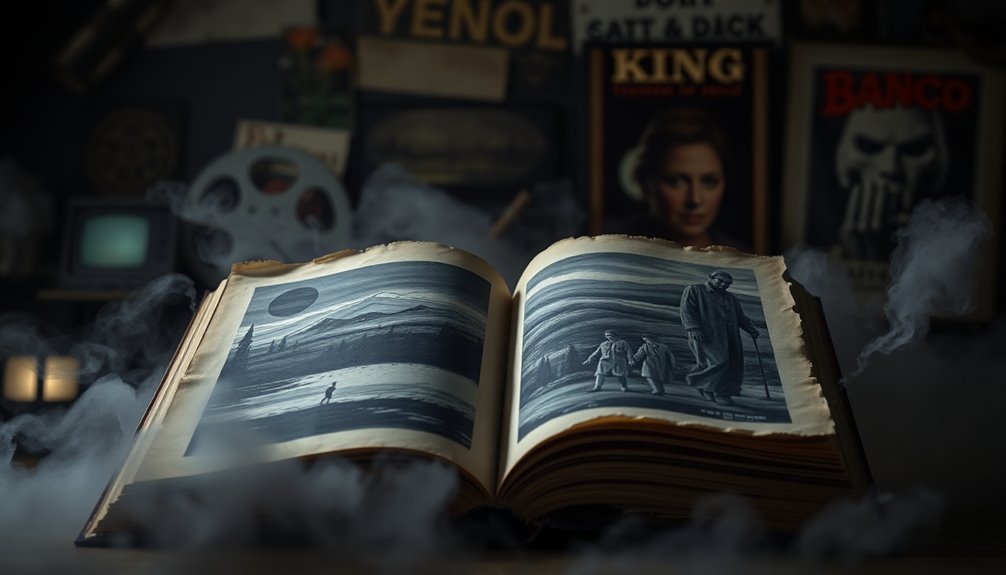
The enduring popularity of "The Stand" has naturally led to multiple adaptations, each interpreting King's vision in unique ways. The first adaptation, a 1994 miniseries, featured a notable cast with Gary Sinise and Jamey Sheridan as Randall Flagg. While it received mixed reviews, it developed a devoted cult following.
Fast forward to December 2020, and CBS All Access premiered a modernized take on the story, showcasing a diverse cast, including Whoopi Goldberg as Mother Abigail and Alexander Skarsgård as Randall Flagg.
This recent adaptation introduced new content penned by King himself, which stirred up discussions about its fidelity to the original novel. Pacing and character development became points of contention, with the 2020 version facing criticism for uneven storytelling and predictable arcs compared to the depth found in the original text.
Viewership fluctuated, influenced by the pandemic, echoing the themes of survival and societal collapse present in the narrative.
Ultimately, both adaptations offer distinct interpretations, but they highlight the ongoing challenge of bringing King's complex characters and themes to life on screen. Each adaptation invites you to experience "The Stand" from a different perspective.
Connections in King's Universe
Delving into King's universe reveals a complex web of connections that enrich the reader's experience. At the center of this tapestry is Randall Flagg, a character who embodies chaos and corruption. He first appears in "The Stand" but also plays a pivotal role in the "Dark Tower" series, showcasing King's multiverse concept. This shared universe allows for an exploration of the battle between good and evil, a theme that resonates throughout King's writing.
Consider these connections:
- Flagg's evolution from a minor figure to a central antagonist in "The Stand."
- The catastrophic plague that sets the stage for survival in "The Stand" and echoes in works like "Cell."
- The intertwining of characters and themes across King's novels, enriching the narrative.
- The influence of the "Dark Tower" series on the understanding of King's universe.
These elements create a distinctive atmosphere, where the struggles faced by characters in "The Stand" resonate throughout King's body of work.
The intricate connections not only enhance your reading experience but also invite you to explore deeper themes in King's expansive literary world.
Personal Reflections and Insights
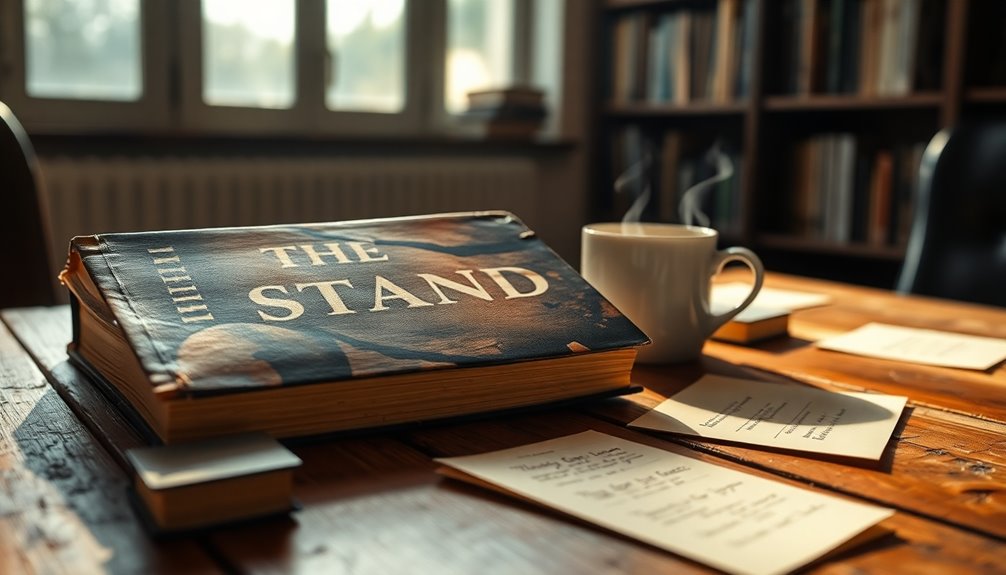
Many readers find themselves grappling with a mix of admiration and frustration when revisiting "The Stand." While its expansive narrative and rich character development draw you in, some sections can feel laborious, testing your patience.
As a King fan, you might appreciate the intricate character arcs that unfold throughout the story. Each character faces moral dilemmas that not only reveal their true selves but also reflect the complexities of human nature.
The post-apocalyptic themes resonate powerfully, especially in light of contemporary societal challenges. You might find yourself connecting the struggles of the characters to real-world issues, particularly during times of crises. This connection can evoke a strong emotional response, prompting deep reflection on the moral choices we make as individuals and a society.
However, some readers express dissatisfaction with certain resolutions, feeling that not every character's journey concludes satisfactorily.
These varied impressions underscore the novel's impact, as it continues to inspire discussions on its relevance even decades after its release. Ultimately, "The Stand" remains a significant work, challenging you to contemplate the delicate balance between hope and despair in an uncertain world.
Conclusion
In wrapping up your journey through "The Stand," it's clear you've encountered a tale that's more than just a story; it's a profound exploration of humanity's resilience. King's vivid storytelling and intricate characters invite you to reflect on the best and worst of us. So, as you close the book, you're not just saying goodbye to a world ravaged by chaos but embracing the hope that springs anew from the ashes of despair.
